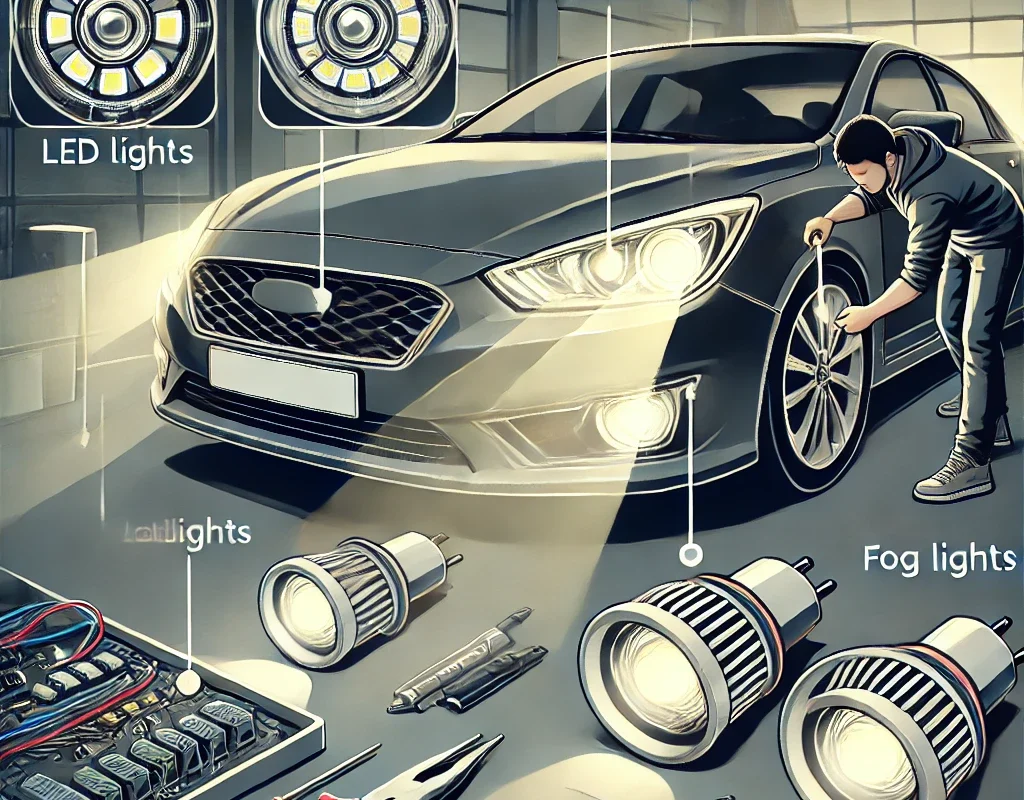LED lighting technology has quickly become the go-to choice for drivers seeking brighter, longer-lasting, and energy-efficient lights. Installing LED lights in your car improves both visibility and aesthetics, making nighttime driving safer and adding a sleek, modern look. With LED lights, you can customize your car’s lighting setup, enhance its style, and improve road safety—all while consuming less power than traditional bulbs.
Understanding LED Lights: Types and Functions
LED lights come in various types, each suited for different purposes. In automotive applications, common LED types include headlights, fog lights, interior lighting, and accent lights. Each type offers unique benefits:
- Headlights provide main illumination for nighttime driving.
- Fog lights improve visibility in adverse weather conditions.
- Interior lights enhance cabin aesthetics and provide ambient lighting.
- Accent lights add a stylistic touch to areas like under the dashboard or seats.
Understanding the different types of LED lights and their functions can help you choose the right setup to achieve both improved visibility and an aesthetic upgrade.
Why LED Lights Are Superior for Car Visibility
Compared to halogen or HID lights, LEDs stand out in several ways:
- Brightness: LED lights emit a more intense light, which improves clarity and distance.
- Longevity: With lifespans up to 50,000 hours, LEDs last significantly longer.
- Energy Efficiency: LEDs consume less power, reducing strain on your vehicle’s battery.
- Color Temperature: LEDs often have a higher color temperature, providing a cooler, daylight-like light that enhances contrast and reduces eye fatigue.
These benefits make LED lights an excellent choice for boosting nighttime visibility and reducing the risk of road accidents.
Choosing the Right LED Lights for Your Car
Selecting the right LED lights depends on several factors:
- Compatibility: Ensure the LED bulbs you select are compatible with your car’s make and model.
- Brightness Level: Choose brightness levels that comply with local regulations.
- Color Temperature: Opt for cooler temperatures for visibility and warmer ones for aesthetics.
- Durability: Look for waterproof, shock-resistant LEDs to withstand road conditions.
Many car-specific LED light kits are available on the market, making it easy to find a set designed for your vehicle’s specific needs.
Tools You Need for Installing LED Lights
Before you start the installation, gather the necessary tools:
- Screwdriver set
- Socket wrench set
- Trim removal tools
- Voltage tester
- Electrical tape and zip ties
- LED light kit (including necessary wiring harness)
These tools will ensure a smoother installation process, allowing you to secure and test the lights effectively.
Safety Tips Before Installing LED Lights
Safety should be your top priority when installing LED lights:
- Disconnect the car battery to prevent electric shock.
- Use protective gloves to avoid burns from heat generated by other components.
- Make sure the car is in a well-lit and ventilated area.
- Avoid contact with sensitive electronic components to prevent damage.
Following these tips helps prevent potential issues and ensures a successful installation.
Installing LED Headlights
Preparing for Headlight Installation
Installing LED headlights requires proper preparation:
- Check Compatibility: Verify that the LED kit fits your car’s headlight housing.
- Read Instructions: LED kits come with instructions tailored to the specific product.
- Disconnect the Battery: Remove the negative terminal from the battery to avoid electrical issues.
Step-by-Step Guide to Installing LED Headlights
- Access the Headlight Housing: Open the hood and locate the headlight housing.
- Remove Existing Bulbs: Twist the old bulbs counterclockwise and carefully pull them out.
- Install LED Bulbs: Insert the LED bulbs, ensuring they lock in place.
- Connect Wiring Harness: Attach the wiring harness, following the manufacturer’s instructions.
Wiring and Testing LED Headlights
After installation, connect the wiring and test the lights:
- Reconnect Battery: Secure the negative terminal on the battery.
- Test Headlights: Turn on the headlights to confirm they function correctly.
Adjusting Headlights for Optimal Visibility
Ensure your headlights are properly aligned for maximum visibility:
- Use a wall or garage door to project the beam.
- Adjust the beam height and width according to your vehicle’s manual.
Installing LED Fog Lights
Preparing for Fog Light Installation
Fog lights require a different approach than headlights:
- Select Mounting Points: Identify safe and legal positions for the fog lights.
- Gather Required Tools: Some fog lights require additional mounting brackets.
Step-by-Step Guide to Installing LED Fog Lights
- Remove Existing Fog Lights: If your car has pre-existing fog lights, remove them.
- Install LED Fog Lights: Attach the new fog lights in place.
- Wire the Fog Lights: Connect to a power source following the kit’s wiring guide.
Wiring and Testing LED Fog Lights
Follow similar steps as for headlights:
- Test the lights by switching them on.
- Adjust the beam so it illuminates closer to the road for optimal performance in foggy conditions.
Benefits of LED Fog Lights for Improved Visibility
LED fog lights offer enhanced visibility in harsh conditions, cutting through fog and mist with less glare. They are particularly useful for night driving and driving in inclement weather, enhancing safety.
Installing LED Interior and Accent Lights
Benefits of Interior and Accent LED Lights
Interior and accent lighting serve both functional and aesthetic purposes. They illuminate the car’s cabin and allow for customization that enhances the vehicle’s overall ambiance. LED strips or pods can be installed under seats, on the dashboard, or in footwells.
Step-by-Step Guide to Installing Interior LED Lights
- Choose Placement: Decide on areas where you want lighting.
- Secure the Lights: Use adhesive or mounting clips to place the LED strips.
- Connect Wiring: Plug the lights into a compatible power source, often the car’s cigarette lighter or fuse box.
You can also read: How to Differentiate Car Models & Variants: Expert Tips
Tips for Choosing LED Colors for Car Interiors
LEDs come in various colors. For a practical setup, select soft colors like white or blue for visibility without distracting from driving.



